Well ...... I am the Captain ........ but I didn't go into a 3D-scan. I do have clogs, but not painted yellow. They are off bare wood.
Regards, peter
 |
As a way to introduce our brass coins to the community, we will raffle off a free coin during the month of August. Follow link ABOVE for instructions for entering. |
 |
Well ...... I am the Captain ........ but I didn't go into a 3D-scan. I do have clogs, but not painted yellow. They are off bare wood.
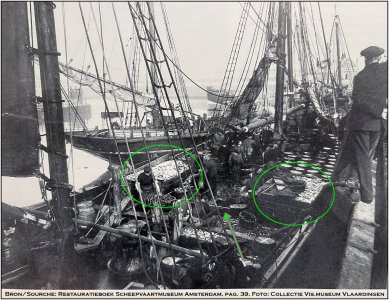

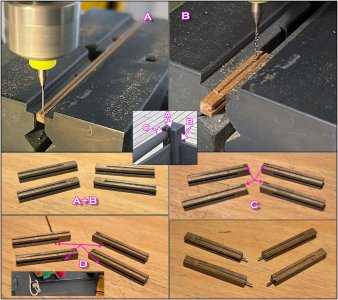
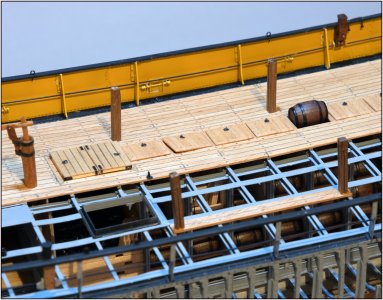





Sorry for you, Christian, but I like my barrels.Peter, I think it's time that you make other barrels. The barrel looks like a toy. It's compared toy your lovely model awful.

Thank you for this nice complimentary post, Paul.See my comment to Maarten about a build that invokes thoughts of the real thing. Here is another one - a model of authenticity and substance. Chapeau, Peter!
My thoughts exactly- Peter is a master.Can you please show us not only fotos from the original ship.
Fantastic details.
True story. Peter and Maartens builds are…..I have no superlatives yet again. It must have something to do with the Dutch beer…. Cheers GrantSee my comment to Maarten about a build that invokes thoughts of the real thing. Here is another one - a model of authenticity and substance. Chapeau, Peter!
My thoughts exactly- Peter is a master.
Thanks, Grant. And I'm not even a beer lover. We've talked about a delicious glass of Scotch whisky before.True story. Peter and Maartens builds are…..I have no superlatives yet again. It must have something to do with the Dutch beer…. Cheers Grant

Hi Dom. Thanks for you visit and compliments. Sometimes there are other things in life which put model building to the background. I’ll hope to see you soon back on your Cutty Sark. That’s still my favorite for a fully rigged clipper.Always inspiring to see your work Peter! Superb attention to detail.
I have sadly ground to a complete halt with my efforts (too much other stuff to do) - I need some of your dedication to the hobby!

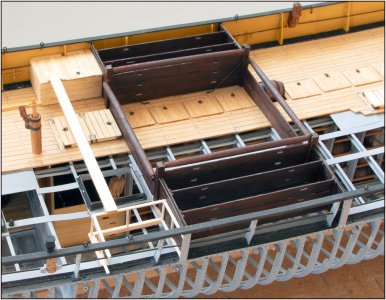

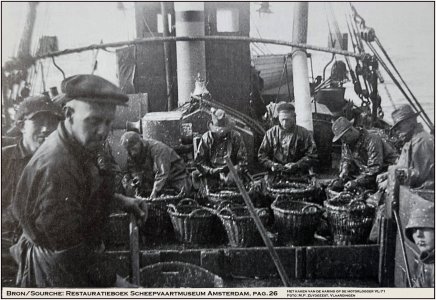
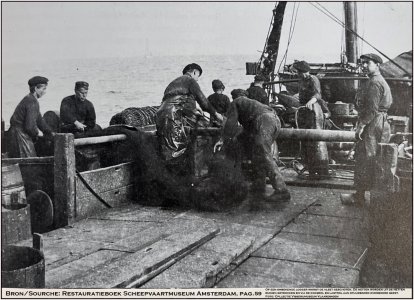
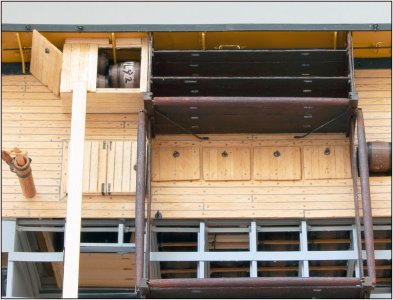
Thanks for this nice post and compliments, Brad. This type of fishing vessel has a very efficient layout and equipment. Of course, that's a development based on previous experiences. In terms of photos, I have the advantage that photography was coming up at that time. And there are enthusiasts who have dug them up from archives and presented them in books and online. The black-and-white photos are often true works of art in themselves.So nice to have the old photographs that show all the details you construct, being used! It's fascinating how many fish were caught, cleaned and stored on such ships, with their small crews!
Your log is wonderful to read, because of this "history" and also the incredible accuracy and details you incorporate. Thanks for sharing!!

Peter my dear friendThis section of the deck is now also finished:
View attachment 559515
A: The two load rollers in the recesses in the uprights. The nets are pulled over these when hauling in.
B: The cook's roller, suspended in brackets on the side of the uprights. This is so called because the cook stands directly behind it and is responsible for stowing the 'vleet' (the fishing nets) in the two net holds. This are the two holds directly behind the roller with the double hatches.
C: The crate. According to the old specifications: "Suitable for stowing provision barrels and the like, and fitted with a removable lid." The specification drawing reads "Box for 4 barrels."
D: the jawing board. This is where the men who gut the herring sit. The sturdy board is also used as an extra gangway.
Viewed from above:
View attachment 559516
On the starboard side only the frame of the crate.
It's a multifunctional unit. Various parts can be removed accordingly. Some old photos might clarify this.
Retrieving the catch:
View attachment 559517
The herring is caught in the 'krebbe' and in the planked area between the 'krebben'. There's also a roller on the bulwark. It's removable and can therefore be used on both sides. I still need to make this. Since I don't have any drawings for it, I'll use old photos and Sybe de Jong's model.
The herring gutters:
View attachment 559518
They sit next to each other on the 'kaakplank' and throw the gutted herring into the baskets. These are salted there and stored in the barrels.
Several parts were removed during the launching of the 'vleet':
View attachment 559519
In the photo: "The fleet is being launched on an unknown sailing lugger. The nets are pulled from the net holds and thrown overboard via the cook's roll and the last roll on the starboard side. The breels, which were brought aft from the 'krebbe' on the foredeck for this purpose, are on the starboard side aft."
Another photo with the open crate:
View attachment 559520
To prevent confusion, the provision barrels were often given a white chalk border with the letters and numbers of the ship in question. Imagine finding a groggy crew member spooning a few scoops of freshly salted herring over the food for the coming days...
It's always nice to be able to show historically accurate material.
Regards, Peter
Thanks for the compliments, Shota.Peter my dear friend
yes are doing incredible work!!
